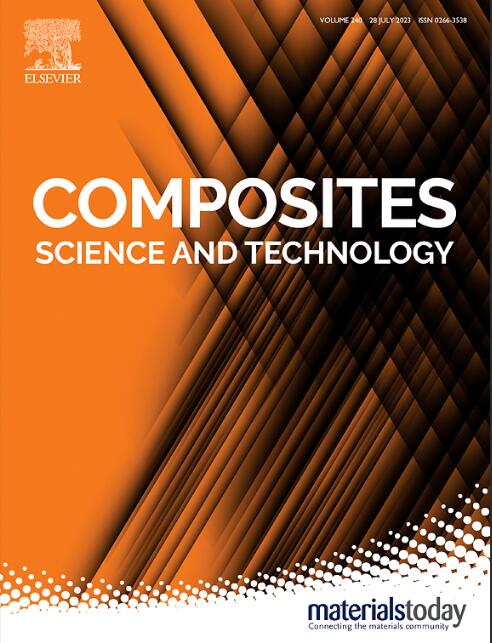集成BN@ZnO/醋酸纤维素复合薄膜,增强导热性和日间被动辐射冷却
IF 9.8
1区 材料科学
Q1 MATERIALS SCIENCE, COMPOSITES
引用次数: 0
摘要
虽然利用辐射冷却技术可以在阳光下达到冷却效果,但由于其固有的低导热性,很难缓解在室外环境下工作的电子设备内部的热量,甚至会导致温度升高。在此,我们开发了一种新型的高导热辐射冷却膜BN@ZnO/醋酸纤维素,该膜采用复合填料策略在光学散射体上构建热传导途径。通过原位沉积合成BN@ZnO填料,构建了有利于Mie散射的微米/纳米级分层结构,使太阳光谱反射率达到93.3%。同时,ZnO纳米棒桥接BN微米片的分层结构显著提高了复合膜的面内导热系数(3.5 W/(m·K))和通面导热系数(1.2 W/(m·K))。在炎热的中午,BN@ZnO/醋酸纤维素复合膜达到4.1°C的亚环境冷却性能。更重要的是,薄膜的高导热性极大地促进了冷源的高效利用。BN@ZnO/醋酸纤维素膜对具有内部热源的室外操作设备实现了6.3℃的实用冷却,而具有先进辐射冷却性能的低导热传统多孔醋酸纤维素膜仅达到0.4℃的效果。这项工作为高导热辐射冷却材料的设计提供了一种新方法,对降低能耗、提高运行可靠性和延长室外设备的使用寿命具有重要意义。本文章由计算机程序翻译,如有差异,请以英文原文为准。

Integrated BN@ZnO/cellulose acetate composite films with enhanced thermal conductivity and daytime passive radiative cooling
Although the utilization of radiant cooling technology achieves a cooling effect in sunlight, it is hardly able to alleviate the heat inside electronic devices operating in outdoor environments, and even leads to an increase in temperature due to its inherent low thermal conductivity. Here, we developed a novel high thermal conductivity radiant cooling film BN@ZnO/cellulose acetate, which was achieved by employing a composite filler strategy to construct thermal conduction pathways on optical scatterers. The BN@ZnO fillers, synthesized by in situ deposition, construct a micron/nano hierarchical structure conducive to Mie scattering, resulting in a solar spectral reflectance of 93.3 %. Meanwhile, the hierarchical structure that ZnO nanorods bridging the BN micron sheet significantly enhanced the in-plane (3.5 W/(m·K)) and through-plane (1.2 W/(m·K)) thermal conductivity of the composite film. In the hot midday, the BN@ZnO/cellulose acetate composite film achieves a sub-ambient cooling performance of 4.1 °C. More importantly, the high thermal conductivity of the film significantly facilitates the efficient utilization of the cold source. The BN@ZnO/cellulose acetate film achieves a practical cooling of 6.3 °C for the outdoor operating equipment with internal heat sources, while the low thermal conductivity traditional porous cellulose acetate film with advanced radiative cooling performance shows an effect of only 0.4 °C. This work provides a novel approach to the design of highly thermally conductive radiant cooling materials and offers significant implications for reducing energy consumption, improving operational reliability and extending service life of outdoor equipment.
求助全文
通过发布文献求助,成功后即可免费获取论文全文。
去求助
来源期刊

Composites Science and Technology
工程技术-材料科学:复合
CiteScore
16.20
自引率
9.90%
发文量
611
审稿时长
33 days
期刊介绍:
Composites Science and Technology publishes refereed original articles on the fundamental and applied science of engineering composites. The focus of this journal is on polymeric matrix composites with reinforcements/fillers ranging from nano- to macro-scale. CSTE encourages manuscripts reporting unique, innovative contributions to the physics, chemistry, materials science and applied mechanics aspects of advanced composites.
Besides traditional fiber reinforced composites, novel composites with significant potential for engineering applications are encouraged.
 求助内容:
求助内容: 应助结果提醒方式:
应助结果提醒方式:


